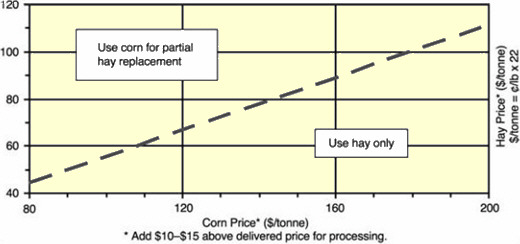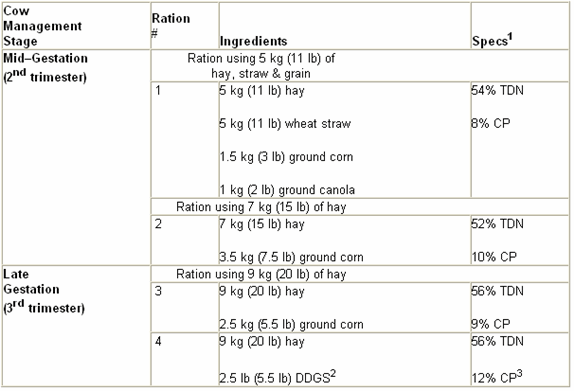



Coping with Hay Shortages in Beef Cow Wintering Rations
By Christoph Wand - Beef Cattle, Sheep and Goat Nutritionist/OMAFRA. Poor summer weather conditions and hay shortages often create feeding concerns for cow/calf producersCulling, reducing wastage, substituting grain for hay or reducing feed requirement are all strategies for maintaining cows when hay inventories are low. This Factsheet discusses hay substitution and reducing feed requirements.
Hay Substitution
When hay is expensive, it may make sense to replace some of the hay in winter diets with grains. Corn (and other grains or by-products) can be used very effectively to partially replace hay. For example, 1 kg of corn can displace 2 kg of hay up to about one-third of the ration. This rule of thumb is based on typical energy and moisture contents of corn and cow hay. It all boils down to economics and managing the livestock and ration under your circumstances.
Figure 1 shows price breakpoints where corn is economically equivalent to hay, assuming 1 unit of corn replaces 1.8 units of hay (conservatively). For example, if hay costs more than $97/tonne (4.4¢/lb) and corn costs $175/tonne (or less), it becomes cost effective to replace some of the hay in the ration with corn. Since grain typically needs to be processed for beef cows to ensure availability, a milling or rolling premium of $10–$15/tonne should be considered in the decision process.
Figure 1. Price decision graph for substitution of hay by corn.
Cost Breakpoint for Corn/Hay Substitution
By introducing grain or any supplemental feed, a cow ration typically becomes a limit-fed (restricted) diet. This means there must be enough bunk space for each animal in the group to eat at the same time. If bunk space is limited, the timid animals will not get their required share. Just like the “rich get richer,” the fat cows get fatter. With limit feeding, beef cows and heifers each require 65–75 cm (26–30 in.) of bunk space, compared to less than one-third of that amount with self-fed (free-choice) systems. Although their nutrient needs will be met with a smaller volume of feed, the animals will still feel hungry.
Other opportunity feeds such as dried corn distillers’ grains (DDG or DDGS) present themselves in the hay-reducing equation. This product has the added benefit of being pre-ground, higher in protein and with less acidosis-causing potential when compared to ground corn for beef cows. It is an ideal choice in cases where a small amount of a high-energy, moderate protein source is needed. Similarly, barley should be valued at about 90% of corn as an energy source, while wheat is equal to or slightly higher than corn. Corn silage — half corn grain and half forage, for these purposes — is another possible substitute.
Grain should not exceed one-third of the total ration. For example, a diet for a 635-kg (1,400-lb) beef cow that was eating 13–14 kg (28–31 lb) of hay/day can be changed to 9 kg (20 lb) of hay plus 2.5 kg (5 lb) of grain. That means the ration would be: 2.5 kg grain ÷ 11.5 total x 100 = 22% grain. The upper limit for grain would be 7 kg (15 lb) of hay plus 3.5 kg (7.5 lb) of grain, making the ration 3.5 kg grain + 10.5 kg total ration x 100 = 33% grain. This latter scenario requires the division of the grain into at least two feedings per day, or the use of a total mixed ration (TMR) delivery and good management. Keeping the hay replaced at one-third, rather than half, will also help keep the hunger response from being too extreme. Some ration ideas and associated limitations are given in the tables in this Factsheet.
Table 1 gives example rations to replace 13–14 kg (28–30 lb) hay intake per 635-kg (1,400-lb) cow per day. This assumes mid-bloom grass hay at 57% total digestible nutrient (TDN) and 10% crude protein (CP). In addition to the ingredients listed, all rations should have mineral included. This can be either mixed in with the grain, fed free choice or mixed in a TMR.
Table 1. Example of dry cow rations with hay substitution.

- Nutrient content based on (13-kg) 28-lb intake equivalency.
- Dried distillers’ grains with solubles.
- Ration protein content somewhat higher than required.
Reducing Feed Requirements
Cold-stressed livestock need more feed just for maintenance than their unstressed counterparts. This is one reason barn-housed animals often perform better. One way to reduce maintenance requirements is by manipulating body condition score (BCS: 1 to 5, Canadian system). Ideally, a cow should be at a BCS of 3.5 at calving. Bringing a 590-kg (1,300-lb), March 1 calving cow from a condition score of 2.5 at weaning to 3.5 requires extra feed, one way or another, equivalent to around 205 kg (450 lb) of decent-quality hay or 115 kg (250 lb) corn. The extra insulation associated with that 3.5 condition score can reduce heat loss come the windy cold of late January and February. So, putting on the extra condition in the fall versus trying to do it in January may reduce the feed required per day over the winter.
Reducing Wind and Mud (Manure) Stress
The extra feed energy required in a windy wet lot is much higher than in a dry, wind-sheltered lot. For example, a clean, British breed (thick-skinned) cow in a sheltered wintering yard with 1.6-km/hr (1-mph) winds at –12°C needs:
- 5% less feed than the same cow in 16-km/hr (10-mph) winds
- 11% less feed than the original cow with a wet, matted coat
- 26% less feed than the same cow with a wet, matted coat in 16-km/hr winds
- 34% less feed than a wet, dairy-type cow with thin hide in 16-km/hr winds
In practice, that means cows exposed to these conditions will either need grain or lose weight because they can only eat so much hay. Alternatively, these examples can be used to put some dollar values on the extra feed used in those critical 2–6 weeks of winter.
Table 2. Wind chill effects for cattle with clean, dry winter coats1 and resulting additional feed requirement. 2

1Values are effective environmental temperatures.
2Adapted from OMAFRA Factsheet Cold Stress in Cows, Order No. 07-001.
Table 3. Effective temperature and the additional hay or grain required to meet the cow's energy requirements. 1

1 Adapted from OMAFRA Factsheet Cold Stress in Cows, Order No. 07-001.
Feed Additives
One additional way to reduce feed requirements is by using certain feed additives, including the ionophores. These will make rumen fermentation more efficient and may reduce feed intake while improving the ration’s utilization. This technology must be implemented carefully, either through a supplement pellet or via a TMR system. Either way, discuss any use of feed additives with a nutritionist or feed industry professional before proceeding.
January 2008

